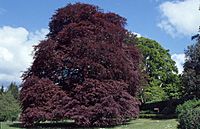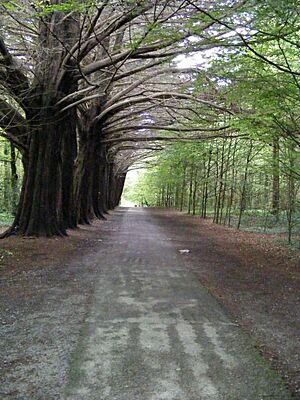Coole Park facts for kids
Coole Park is a beautiful nature reserve in County Galway, Ireland. It covers about 1,000 acres (400 hectares) and is managed by the Irish National Parks & Wildlife Service. This special place is known for its unique seasonal lakes called turloughs. These lakes are almost only found in Ireland. The park also has many woodlands. You can explore 6 kilometers of nature trails and visit a historic walled garden from the late 1700s.
Contents
A Look Back in Time
Coole Park used to be the home of the Gregory family. Their large house, Coole House, was built in the late 1700s for Robert Gregory. It was a three-story house with big windows. These windows looked out over Coole Lough and the Burren Hills.
In 1880, Robert's great-grandson, William Henry Gregory, married Isabella Augusta Persse. She became famous as Lady Gregory. She was a very important person in Irish literature.
Lady Gregory and her family were friends with many famous writers. These writers were part of the Irish Literary Revival. This was a time when Irish writers created many amazing plays and poems. Sadly, Lady Gregory's only child, Robert, died in World War I. He was a pilot. This inspired the poet W. B. Yeats to write poems like "An Irish Airman Foresees His Death."
The Autograph Tree
In the park's walled garden, there is a special tree called the autograph tree. It's a copper beech tree. Many famous writers carved their initials into its bark. These writers were friends with Lady Gregory. They included W. B. Yeats, Edward Martyn, George Bernard Shaw, John Millington Synge, and Seán O'Casey.
W. B. Yeats also wrote another famous poem, "The Wild Swans at Coole." He was inspired by the beautiful swans on the turlough at Coole Park. Yeats lived only 3 miles away at Thoor Ballylee. He also wrote "Coole Park, 1929," which describes the park as a symbol for Irish literature coming back to life.
The Coole House was damaged during the Irish Civil War (1922–23). Lady Gregory sold the estate to the Irish government in 1927. She continued to live there until she died in 1932. The house was later taken down in 1941. Today, only the base where it stood remains.
Visiting Coole Park Today
The park grounds are open to everyone all year round. There is no admission fee. A visitor center is located in the old buildings from the 1700s. It is open during the busy season, from April to September.
At the visitor center, you can enjoy a tea room. There is also a video about Lady Gregory and the park's literary history. You can also see an exhibition called "Coole Park through the eyes of 'Me and Nu'." This exhibition shares stories from Lady Gregory's granddaughters.
In 2014, many trees in Coole Park had to be cut down. This was because of a disease that made them unsafe. The National Parks and Wildlife Service (Ireland) confirmed this was necessary.
Nature and Wildlife
The unique way turloughs fill and empty creates a special environment for plants and animals. Turloughs are considered a very important habitat in Europe.
Coole Park is part of a larger area called the Coole-Garryland Complex. This area is protected as a special place for nature.
Protecting Birds
Coole Lough and Garryland Wood have been protected since 1990. They are recognized as a Wetland of International Importance under the Ramsar Convention. This means they are very important for nature around the world.
The park is also a special place for birds. It is a wildfowl sanctuary, which means hunting game birds is not allowed. This area is protected under the Wildlife Act 1976. It is especially important for whooper swans that spend the winter here. This protection helps many different kinds of birds.



